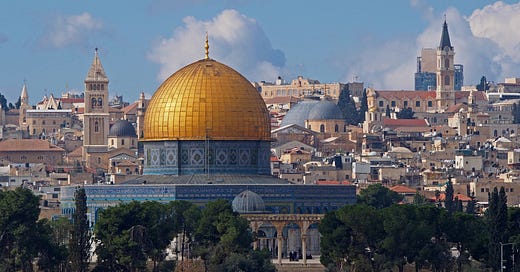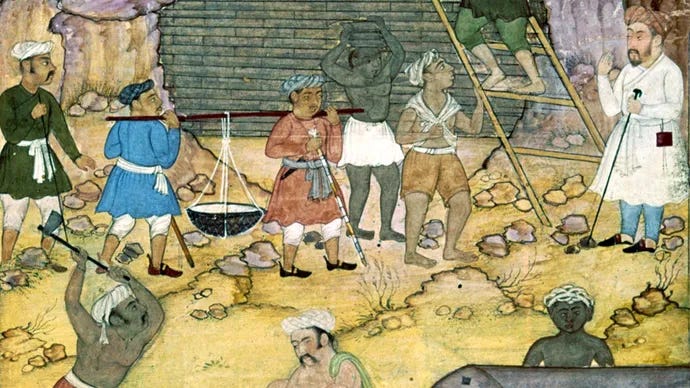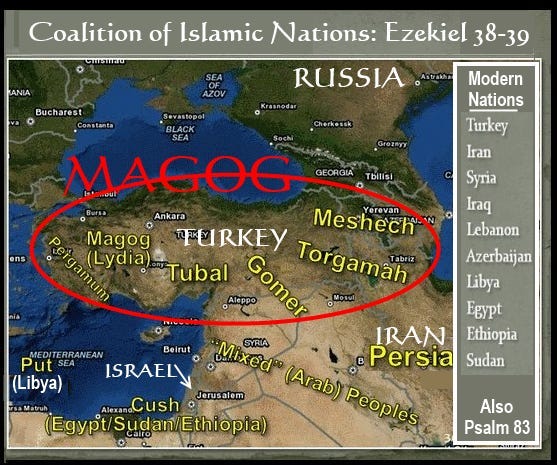Ya'juj and Ma'juj - The End Times in Islam
Animating prophetic pages from the Torah, Bible and Qur'an
This is our second piece on Gog and Magog; the first is here. In this new and expanded narrative we aim to encapsulate a broader view of Gog and Magog through the lens of Ya'juj and Ma'juj in Islamic prophecies. This will encompass both Judeo-Christian and Islamic eschatologies, and highlight their significance in contemporary religious and geopolitical dialogues.
We also hasten to note the current “eschatological frenzy”1 was begun not by a Christian Evangelical Third Temple construction crew, but rather by a savage outburst of barbaric Islamic blood lust. Radical Islam are by far the world’s most energized End Time enthusiasts. It is they who actively seek to precipitate the Gog and Magog war. It is they who seek to annihilate a UN-sanctioned nation-state.2 And it is they who call for genocide against Jews.
The current conflicts in the Middle East, while not yet fulfilling the full scope of the prophesied war, can be seen as precursors to the foretold end times confrontation. These ongoing disputes and skirmishes may well be the opening salvos of a larger, more devastating conflict that, according to prophecy, will eventually draw in regional powers such as Iran and Turkey.
As the situation continues to unfold, it is crucial to remain vigilant and prepared for the possibility that these present-day hostilities could escalate into the prophesied Gog-Magog war.
It also is possible the world will step back from the brink. Of course, this is our fervent desire. However, once the wind-whipped flames of hate and eschatology crackle and rage, as they now do, it becomes nearly impossible to extinguish them. As Alastair Crooke recently noted, “The reality of the necessity of war is permeating widely the consciousness of the Arabic and Islamic world.”
In the colorful and perplexing quilt of religious eschatology, the enigmatic figures of Gog and Magog occupy pivotal roles across multiple faith traditions, namely Christianity, Judaism and Islam. The interweaving of these figures with prophetic visions offers an enlightening commentary on the culmination of history as envisioned within these faiths.
The Old Testament books of Genesis, 1 Chronicles and Ezekiel, as well as the New Testament's Revelation, introduced us to the coalition of nations led by Gog from the land of Magog. These passages have historically been subjected to both literal and symbolic exegeses, influenced by the prevailing and unpredictable winds of theology and geopolitics.
In line with mainstream Christianity, Orthodox eschatology recognizes Gog and Magog as symbols of the nations and their leaders that will align against God's people. However, Orthodox teachings generally avoid the detailed speculation about these entities common among evangelical interpretations.
The Islamic corpus adds yet another layer to this complex narrative with the concept of Ya'juj and Ma'juj, the Quranic counterparts to Gog and Magog and the principle players in this piece.
Described in Islamic eschatology as two barbarous tribes hidden behind a vast wall, their eventual emergence will signal a time of unprecedented turmoil and strife. Within the Islamic tradition, these entities symbolize rampant corruption and chaos, breaking forth in the world before the Day of Judgment. Are these two “barbarous tribes” mentioned in the Qur’an evocative of Hamas and Hezbollah?
Ezekiel, Revelation and Al-Kahf: A Comparative View
In Ezekiel, the prophecy situates Gog and Magog as direct antagonists to Israel, signifying an eschatological threat. Conversely, Revelation casts them as deceivers, leading nations astray to wage war against the divine encampment, only to be thwarted by divine intervention.
At this juncture, it is imperative to note that the Book of Revelation, customarily attributed to John of Patmos, is, at least in my assessment, more a symbolic vision than a literal blueprint for the future.
The Quranic narrative in Surah Al-Kahf, the 18th chapter of the Qur’an, presents Ya'juj and Ma'juj as two hostile groups that will emerge near the end of times, causing widespread destruction. Their reference in Islamic eschatology is closely associated with the apocalyptic scenario, including the advent of the Mahdi and the return of Jesus (Isa in Islam), heralding a period of divine judgment and restoration.
The salience of Gog and Magog in shaping contemporary geopolitical discourse, particularly in the Middle East, is underscored by the way these terms are invoked to interpret and sometimes to justify modern conflicts. Their symbolic relevance transcends historical epochs, influencing international relations and policy-making over the broad landscape of human history.
As the Russian political analyst Alexander Dugin noted, eschatology provides a lens through which the intricacies of present-day geopolitics can be discerned, especially in regions where religious narratives hold sway.3
Interpreting Gog and Magog Symbolically
In the symbolic domain, Gog epitomizes forces opposed to divine will, encapsulating disbelief and secular antagonism. Magog transcends precise geographic identification. It represents the spiritual adversaries who align, perhaps unwittingly, with this opposition.
The intersection of these prophetic images with the state of Israel and the broader concept of a spiritual Israel encompassing all who acknowledge a higher transcendence brings forth the notion of a collective spiritual identity that itself transcends religious and ethnic boundaries. This becomes apparent in the Judeo-Christian interpretation of spiritual Israel, which aligns the historical and spiritual dimensions of Israel with a universal vision of faith and redemption.
In this light, Ezekiel's vision of dry bones (Ezekiel 37:11) is not just a call to the people of Israel but to all of humanity to awaken from spiritual indifference and embrace a vision of transcendence. This resurrection of spirit forms a unifying thread. It has the capacity to bring disparate communities together in recognition of their shared divine heritage.
To understand the distinctive perspective of Islam as one of the three monotheistic Abrahamic religions regarding the concept of a shared divine heritage, it is instructive to examine the biblical narrative of Isaac and the complex figure of Ishmael, son of Abraham and Hagar, his wife Sarah’s maidservant. According to the Bible, God’s Covenant passed through Abraham, Isaac and Jacob.
Jacob, who was later named Israel, fathered twelve sons who became the progenitors of the Twelve Tribes of Israel, and from this lineage, the Israelite identity and the Jewish people emerged.
Gog and Magog in Islamic Eschatology
In Islamic eschatological thought, the emergence of Ya'juj and Ma'juj is a prelude to the final judgment, a time of chaos preceding the restoration of peace and divine order. This belief underscores the cyclical nature of moral decay and renewal inherent in Islamic theology, mirroring themes also found in the Bible.
Thus, the narratives of Gog and Magog and their Islamic analogues Ya'juj and Ma'juj, resonate deeply with the eschatological themes of chaos, divine intervention and ultimate redemption. Their stories, serving as a confluence of prophetic visions, offer insight into the universal human condition and the quest for spiritual truth and reconciliation.
Certainly, the concept of Gog and Magog holds a significant place in eschatological narratives, which are indeed receiving a notable amount of attention today in various media outlets. The eschatological lens through which these entities are viewed frequently colors the interpretation of current events, especially those pertaining to geopolitical strife.
The perceptions of Ya'juj and Ma'juj within the Islamic tradition, and the divergent understandings held by Sunni and Shia Muslims, can be considered to illustrate the complexity and nuance of Islamic eschatological thought. Now, a brief look at both:
Sunni Perspectives
In Sunni Islam, which comprises the majority of the Muslim world,4 Ya'juj and Ma'juj are understood as chaotic forces that will appear towards the end of times. Their emergence is commonly interpreted as a sign of the Day of Judgment's proximity.
Sunni eschatology typically relies on the canonical Hadith collections for details about these end-time events and these collections include numerous references to Ya'juj and Ma'juj. The Hadith in Islam serves a similar function to the Talmud in Judaism, offering interpretations, legal discussions and narratives.
Shia Perspectives
Shia Islam, particularly the Twelver sect, the largest branch of Shia Islam, also recognizes the Quranic and Hadith descriptions of Ya'juj and Ma'juj. However, Shia eschatological narratives are heavily influenced by the belief in the Mahdi, the prophesied redeemer, who is said to appear before the Day of Judgment to establish justice.
Twelver Shi’ism, also known as Imāmiyya, holds a central position in Iran that it has occupied for over 1,000 years. Twelver Shi’ism encompasses a rich theological and spiritual framework, emphasizing the role of imams and the anticipation of Imam al-Mahdi’s return. It has a strong eschatological dimension.
The advent of Ya'juj and Ma'juj in Shia thought is often linked with the anticipated return of the Mahdi. While the Mahdi is not comparable to Jesus in divinity or prophethood, there is a semblance of comparison in their respective roles in Islamic eschatology concerning the end times and the establishment of justice on earth.
One additional observation I find intriguing. As previously noted, Shia Muslims believe the Mahdi to be the twelfth Imam, Muhammad al-Mahdi, who is said to have been born in the 9th century and to have gone into occultation, the temporary, supernatural removal of a holy person from visible existence.
Islamic Geopolitics
The eschatological beliefs concerning Ya'juj and Ma'juj play a role in the geopolitical landscape of the Islamic world. For instance, in regions where literal interpretations prevail, there is an expectation that current conflicts are paving the way for the apocalyptic events we’ve detailed, thus influencing the political rhetoric and justifying certain actions on the international stage.
Indeed, this notion is surely prevalent within Hamas. The terrorist organization believe they represent at least one of the catalysts that will usher Ya'juj and Ma'juj (Gog and Magog) prophecies into the fullness of time.
Conversely, in communities interpreting these prophecies metaphorically, the emphasis tends to shift away from pinpointing specific geopolitical events as apocalyptic indicators, to fostering a moral and spiritual readiness for whatever the future holds. This allegorical understanding is believed to encourage introspection and ethical conduct as precursors to eschatological fulfillment.
It is this intricate interpretation that renders a complete understanding of Ya'juj and Ma'juj both challenging and imperative. A nuanced, more cursory comprehension of these varying interpretations will hopefully untangle the complex ways in which spiritual beliefs can cast long shadows over the political actions and interactions of Islamic nations.
Thus, through exploring the rich spectrum of beliefs surrounding Gog and Magog and Ya'juj and Ma'juj prophecies, we also hope to have provided Rational Spirituality’s readers with a textured understanding of their impact.
It becomes more and more evident that the threads of ancient prophecies are woven into the fabric of modern geopolitics, illustrating how deep-seated convictions, whether rooted in literal or allegorical soil, continue to influence the strategies and narratives that define our broken world today.
The state of Israel's establishment in 1948 was pursuant to UN General Assembly Resolution 181, which recommended the partition of the British-ruled Palestine Mandate into a Jewish state and an Arab state. Rather than accept this would-be Two State Solution, the following day a coalition of Arab states, including Egypt, Iraq, Jordan (then known as Transjordan), Lebanon, and Syria, initiated a military campaign in the region, leading to the outbreak of the 1948 Arab-Israeli War. The conflict resulted in a military victory for Israel, similar to how the American Colonies achieved victory over Great Britain in 1776.
In his book "Last War of the World-Island: The Geopolitics of Contemporary Russia" (2015), Dugin argues that the world is on the brink of a final, apocalyptic conflict between the forces of tradition and the forces of globalization, drawing upon religious and eschatological narratives to support his claims.
Sunni Countries: Saudi Arabia, Egypt, Turkey, Jordan, Qatar, UAE, Kuwait, Yemen, Somalia, Algeria, Morocco, Tunisia, Libya, Sudan, Nigeria, Afghanistan, Uzbekistan, Turkmenistan, Tajikistan, Pakistan, Bangladesh and Indonesia.
Syria (Sunni Muslims form the majority of the population, despite the ruling regime being Alawite, a sect of Shia Islam)
Iraq (although there is a significant Shia population as well)
Bahrain (although the ruling family is Sunni, the majority of the population is Shia) Bahrain is a vassal state of Saudi Arabia.
Palestinians are predominantly Sunni Muslims. There is, however, a small minority of Shia Muslims among them, as well as Christians and other religious groups. Hamas is a Sunni Islamic fundamentalist organization.
Shia Countries: Iran, Iraq and Azerbaijan. There are significant Shia minority populations in India, Lebanon and Syria. Pakistan is home to one of the world's largest Shia populations in terms of numbers but represent a minority. Hezbollah is a Shia-Islamic militant group and political party based in Lebanon.







